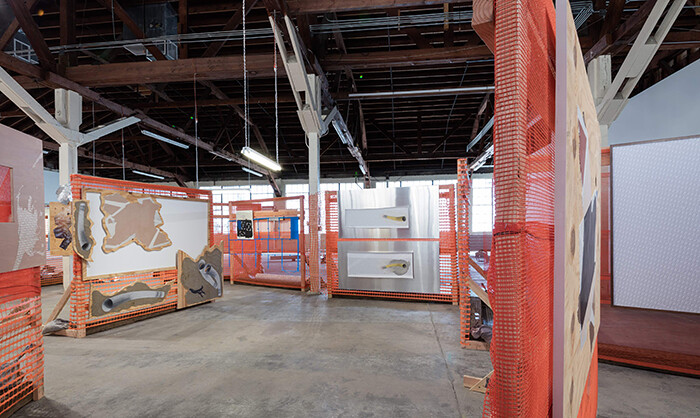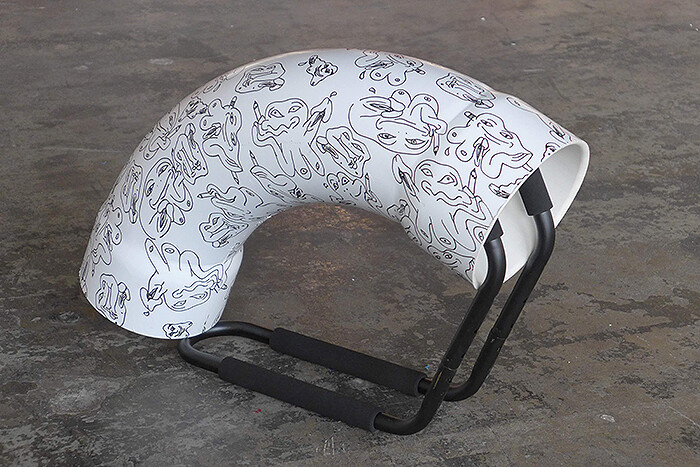To cut to the chase: Seth Price banks on banality. Bides his time building constructs, rather than content; repeating forms overblown by rhetoric. Most famously, his oft-cited essay “Dispersion” (2002) has served as justification for the material choices made in his career, quoting—nay, preaching—redistribution of existing materials as alternative currency to the creation of new form as dictated by the demands of the art market. But, like items made of reclaimed wood at Crate & Barrel, so altruistic and self-aware in offering a way out from buying into all that “new” stuff being made, so too is Price’s art part careful marketing. What’s for sale seems to be the illusion of escape, or capitalism re-branded and snazzily packaged as an “alternate economy”—books readily available to download online, paintings pushing 200k. Quid pro quo. But in the context of post-1990s New York, as long as you’re self-aware and inclined to irony, double standards seem to be okay: after all, participation with the market is measured only in terms of how self-conscious of it you are, or how eloquently you can copywrite that relationship.
Eloquence, at that, can assume many guises and at Los Angeles’s 356 S. Mission Rd. it appears as Price’s latest exhibition, “Wrok Fmaily Freidns.” Evoking words of wisdom from “Dispersion”—“You know what cool? Throw in some misspellings”1 (Los Angeles: Ooga Booga, 2016), 3.]—the titular typos forebode the articulation of the installation, as it slurs through sex, skin disease, collectors, and copyrighted material in a labyrinthine construction site, erected interim for (or as) Price’s provisions. Together, the works read like run-on sentences that seem unrelated but appropriate as a stream of thought, functioning as “spatial metaphors,” as David Joselit described Price’s work,2 for the blurry effect of viewing images or accumulating endless columns of information online. Pragmatically, the materials all nod to modern ruins—the hoards of stuff that lie at the foot of upcoming skyscrapers, or the stockpiled junk that made Rem Koolhaas’s career in writing3—yet do so by taking the flatness of the digital as a starting point, and filling it out to the desired volume. Ideas amass, like rapidly typed messages, total delirium.
Entering, the viewer is guided by provisional paravents of orange plastic fencing, carrying everything from prints of tessellated logos and vector images (for example: Spill Test or Logo Test Scrap, both 2015), found panels inscribed with spaceless sentences (I.D. Construction Barrier, 2016), to prints of pencils emptied at one end to reveal alluring orifices (Strip Test A and Strip Test B, both 2015). In these, Price disarms by overstimulation, lightheartedly coaxing viewers to draw a blank (pun intended) amid his calculated chaos. Elsewhere, sterile-looking PVC pipes printed with hermaphroditic blobs, Waste Pipes (2016), help the mind procrastinate on odd detail, while intermittently installed iPads link to a digital catalogue of collector profiles for anyone to peruse—including personal information about their homes, or “geo-data” as it has been dubbed. Everything is up for grabs. Not only does Price appropriate the ambulatory infrastructure of online communications as a sculptural model, but in doing so, replicates its false democratic promises: the accumulation of sheer content standing in for determinate action, thus reinforcing not the ideology of re-distribution, but the power inherent to the network as a capital system itself. Significantly, Price seems completely aware of this complicity, making his experiments into communicative capitalism-cum-contemporary art conceptually viable by maintaining his authority over choices made. It’s impossible, in other words, to critique someone who is not only completely aware of their critical shortcomings, but further includes those ideas in their practice—as appropriation, as mimicry, or whatever you want to call it. Price’s work is a product of its own critique, a response to the act of contribution in the market itself, which by all intents and purposes is actually kind of (evil) genius, albeit annoyingly so. Yet still, the inevitable question is: where is the line between co-opting the productive methodologies of capital as a means to negate them, and making yourself conveniently available for exploitation by those same systems?
Price’s latest exhibition provokes a stab at an answer. Considering the asking price for the works, still mid-level in today’s market for whatever it’s worth, he has cashed in on content-based critique that arguably only caters to the systems of power it claims to position itself against. The work is legitimized by the audience’s attunement to assertions made by the artist—through subsidiary essays, interview, press, or last year’s Nicolas Tremblay-“curated” ads for luxury menswear designer Brioni, in which Price appears as a model—which are then uncritically correlated to the objects on display. Price’s ideologies, perhaps in failing to respond to the gradual onslaught of art super-stardom, seem to collapse under their own weight, leaving the work itself as little more than another empty embodiment of abstraction and value amassed. And reification, Bruce Hainley reminds in an essay entitled “Justin Bieber Losing His Swag,” “isn’t critique, but you know, whatevs.”4 Perhaps Seth Price, Brioni suit and all, is also losing swag.
Seth Price, Wrok Fmaily Freidns [exh. cat.
David Joselit, “What To Do With Pictures?,” October no. 138 (Fall 2011): 84.
See Rem Koolhaas’s Delirious New York (1978), also about illusionism and urban landscapes.
Bruce Hainley, “Justin Bieber Losing His Swag,” Spike no. 41 (Fall 2014), http://www.spikeartmagazine.com/en/articles/justin-bieber-losing-his-swag.







